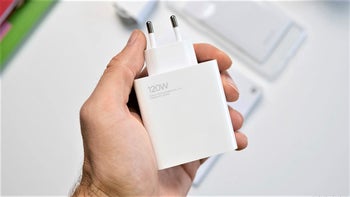Fastest charging phones in 2023

It feels like the race to making faster and faster-charging phones still has ways to go before cooling down, especially when it comes to companies such as Realme, Oppo, Xiaomi, and OnePlus. So how far have we come when it comes to getting pure power into our favorite mobile gadgets, into our phones?
Well, to put it frankly, we have come far. Nowadays there are phones with a 4,600mAh battery that can be charged from 0-100% in just under 10 minutes. Of course, there are many other factors that make up a good phone, so not many will purchase one purely for its crazy charging speeds, but the good news is that even the "slower" charging phones are just about fast enough for today's market.
With all of this in mind, we have compiled the phones with the fastest charging speeds to see which ones stand at the top. Below, you will find the latest bearer of the "fastest charging phone crown," as well as each popular brand's fastest charging phones at the moment. We've also added a few explainers regarding the different charging tech manufacturers use.
Keep in mind that when we say 'fastest charging phones' we refer to the ones with the most powerful charging. In other words, we are looking at the maximum wattage at which these phones can charge and not the amount of time it takes them to charge. While the two statistics correlate each other, they can be affected by the battery capacity, so if a phone supports a rather slow charging speed but comes with a small battery, it can still charge fairly fast.
Which is the fastest charging phone in the world?
Currently, the most recently released fastest charging phone is the Realme GT3. It maxes out at 240W of charging speed which is enough to fill up its 4,600 battery in 9 minutes and 30 seconds. Before it, we had the Redmi Note 12 Explorer, which is capable of 210W charging. A close runner-up is the iQOO 10 Pro that comes with a top charging speeds of 200W, which is advertised as enough to juice up the phone from 0-100% in about 10 minutes.
Technically, Xiaomi's sub brand Redmi showcased the first 300W wired charging on the Redmi 12 Note Pro+. However, that was probably a modified version of the phone, as the retail version only goes up to 120W. Redmi has not stated when and if this 300W charging will reach the consumer market though.
Phone charging speeds by brand
Below, you will find the supported charging speeds for all major phone brands.
| Maker | Phone | Maximum Supported Charge Speed | Power Charging Standard |
|---|---|---|---|
| Apple | iPhone 15 series, iPhone 14 series | 25W | USB-PD |
| iPhone 13 Mini, 13, 13 Pro, 13 Pro Max | 27W | USB-PD | |
| Samsung | Galaxy S23 Ultra, S23 Plus, S22 Ultra, S22+, Galaxy S20 Ultra, Note 10+ | 45W | USB-PD |
| Pixel 8 and Pixel 8 Pro | 27W | USB-PD | |
| OnePlus | OnePlus 10T | 150W | SUPERVOOC Endurance Edition |
| Sony | Sony Xperia 1 IV | 30W | USB-PD |
| Motorola | Motorola Edge 30 Ultra | 125W | USB-PD |
| Huawei | Huawei Mate XS** | 55W | SuperCharge |
| Xiaomi | Redmi Note 12 Explorer | 210W | Navitas GaNFast |
| Oppo | Oppo Find X5 Pro** | 80W | Super VOOC 2.0 |
| Realme | Realme GT 3 | 240W | |
| Vivo | iQOO 10 Pro | 200W |
*phone comes with a slower charger in the box.
**phone comes with a faster charger in the box.
You can find a complete list of all the devices that support the Qualcomm QuickCharge standard here
iPhones Fast Charging Explained
Starting with the iPhone 8 back in late 2017, Apple has adopted the USB Power Delivery standard and all new iPhones released since then, including the recent iPhone 12 family, support this fast charging technology.
However, starting with the iPhone 12 series, Apple no longer includes a charger in the box and you need to purchase one separately. Apple is selling its own official 20W USB-C Power Adapter for around $20, and you will also need a USB-C to Lightning cable if you don't own one.
Can you use a third-party power adapter that is not made by Apple and still get those fast, 20W charging speeds? The answer is mostly yes, but make sure that the adapter you purchase supports the USB Power Delivery (USB-PD) standard. For example, a standard Samsung phone charger also supports the same USB-PD standard and will also deliver a fast charge to iPhones safely. You also have numerous third party options with names like Anker being among the most reliable brands.
Samsung Galaxy Fast Charging Explained
Samsung has been supporting different fast charging standards in the past, but it has finally adopted the widespread USB Power Delivery standard with the Galaxy S20 series and the Note 10 series of phones.
Interestingly, the latest Samsung phones (including the S21 Ultra) don't support the 45W fast charging speeds that Samsung introduced with the Note 10, and instead max out at 25W. Samsung will not officially confirm what's the reason behind that, but long-term battery preservation might be one possible reason.
Earlier Samsung phones like the Samsung Galaxy S10 Plus, S10 and S10e only support the Qualcomm QuickCharge 2.0 standard and they max out at charging speeds of 15W.
Google Pixel Fast Charging Explained
Can you use a faster 25W or 45W power adapter to charge Google Pixel phones even quicker? The answer is no, the phone is configured to receive a maximum charge of 18W so you won't see any benefit from plugging it to a more powerful charger.
LG ThinQ Fast Charging Explained
LG supports the Qualcomm QuickCharge 4.0 fast charging standard with a maximum charge rate of 21 watts on phones like the LG G8X ThinQ and the LG V50 ThinQ, but the charger provided in the box can provide a maximum of 16 watts of power, so you might want to invest in a faster charger to use the maximum speed.
In fact, this 16W charger that goes by the name of LG Travel Power Adapter is compatible with most LG phones like the LG G7, LG G6, LG G5, LG V40, LG V30, LG V20, and even affordable phones like the LG Stylo 5 and LG Stylo 4. This power adapter features a standard USB port, and not the newer USB-C type.
With the newer LG V60 ThinQ, you get a more modern 25W USB-C charger with support for the Qualcomm QuickCharge 4.0+ standard.
OnePlus Fast Charging Explained
OnePlus phones use a proprietary charging standard that uses high current (more Amps) rather than high electric pressure (Volts) to deliver a faster charge.
What this means is two things: one, it is a proprietary solution which means that you need to use the OnePlus charger with the OnePlus cable to make use of the fastest charging speeds (thankfully, both are provided for free in the box), and second, it means that other chargers like a USB Power Delivery charger will not be able to deliver its maximum output on OnePlus phones.
In reality, we have found the proprietary OnePlus charger to work extremely well and one advantage it has over other technologies is that it is able to maintain the fast charging rates even while you are using your phone. On other phones, in contrast, charging rates drop noticeably if you use your phone while charging.
Huawei Fast Charging Explained
Huawei also uses a proprietary fast charging solution that goes by the name Huawei SuperCharge.
Starting with the Mate 20 Pro in late 2018, Huawei is shipping its flagships with a 40W charger that is capable of topping up the phones extremely quickly. Prior to that, the Huawei P20 Pro used a 22.5W fast charger. And recent phones like the Huawei Mate XS foldable now comes with a 65W charger in the box (the maximum charging speeds of that phone are limited to 55W, though).
Can you use a third party power adapter with Huawei phones? The answer is yes, but don't expect to get the same fast charging speeds.
Oppo and Realme Fast Charging Explained
Chinese company Oppo is not popular in Western markets, but its budget off-shoot Realme is picking up pace in many places across the globe, and one of the key selling features is a super fast charging rate.
In fact, the Oppo Ace Reno was the first commercially available phone that would support 65W charging speeds. This phone is able to get a 70% charge in just 15 minutes, and charges fully in about half an hour. Truly impressive. But what technology does it use?
The technology is similar to what is used in OnePlus phones (which are part of the Oppo group of companies). It's called Super VOOC 2.0 and it uses pumps up power at a rate of 10V and 6.5A, and it also uses GaN technology to achieve that in a relatively compact package.
This charger, however, will only work with few very specific phones and will charger other phones at a rate of just 10 watts.
As for Realme phones, the Realme X50 Pro 5G supports 65W charging via the same technology and the phone would also charge at rates of 18W with a QC/PD charger and 30W with the company's Flash Charge power adapter.
Xiaomi and Redmi Fast Charging Explained
The Xiaomi Mi 10 Ultra has raised the bar for the industry and comes with a 120W charger in the box.
The charger provided in the box also supported the QC4.0+ and Power Delivery 3.0 standards, so it is technically compatible with many other phones as well.













Things that are NOT allowed: